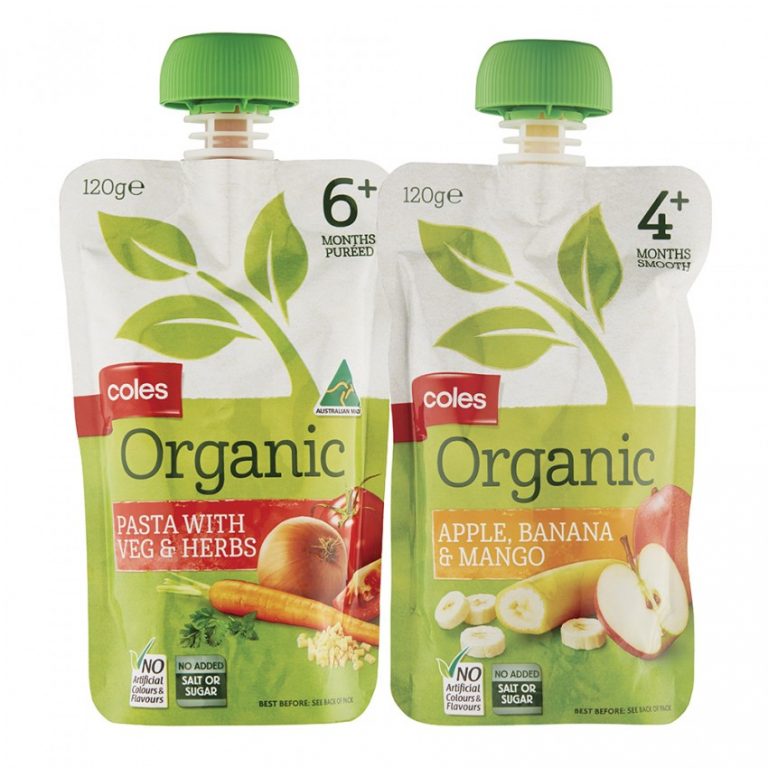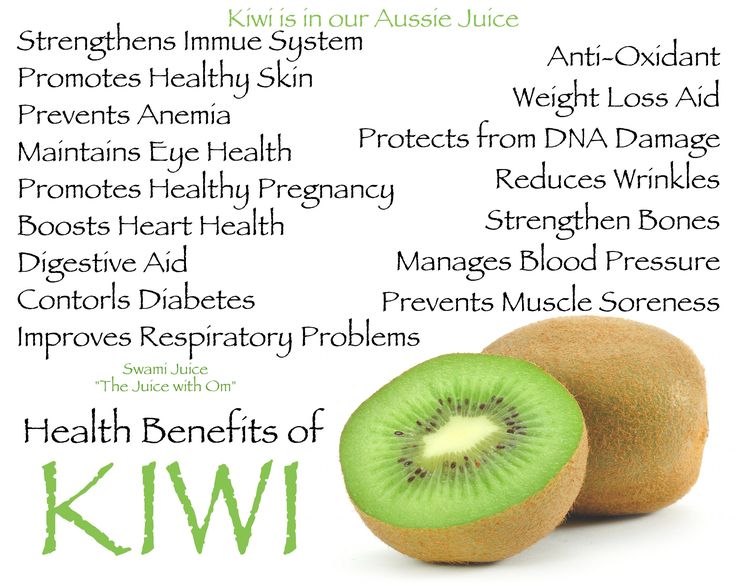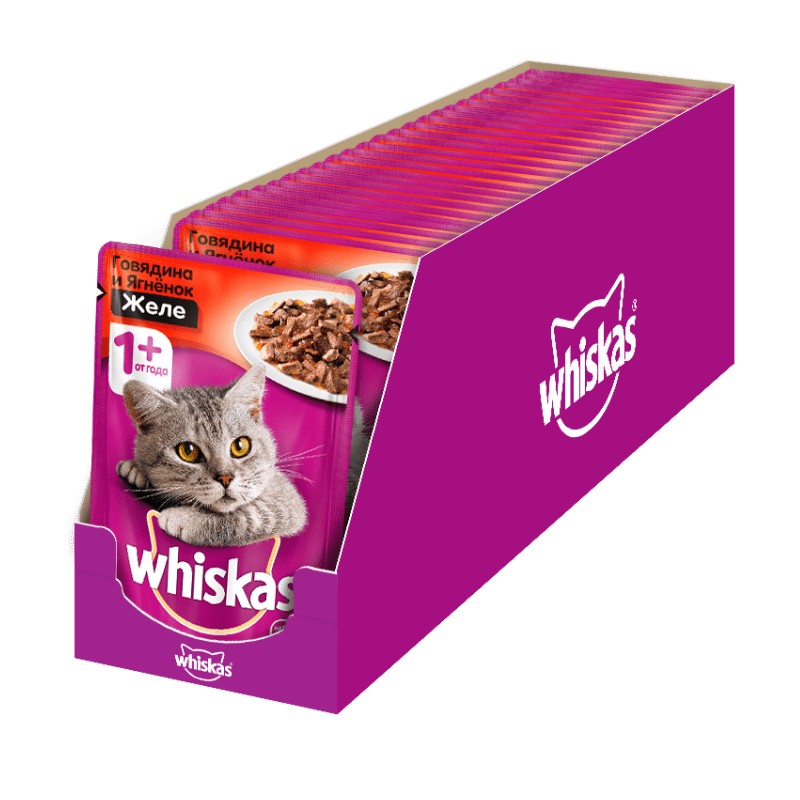When to start baby food pouches
Baby Food Pouches: Pros, Cons and Advice
Should you give your child a baby food pouch?
It hasn’t taken long for baby food pouches to show up in grocery stores and superstores everywhere. You can even find them at some Starbucks!
In fact, it’s safe to say they’ve become part of the nutrition mainstream for babies and toddlers.
Baby food pouches may provide a good source of fruits and/or veggies, with many brands boasting no added sugars, juices, salt or artificial colors and use of all organic ingredients.
Some companies claim their products are cooked at lower temperatures than jarred baby food, increasing their nutrient content.
While the possibilities are endless with these convenient creations, others advise caution when using them.
In this article, you’ll learn:
- The pros and cons of using baby food pouches
- Why it’s important to connect through feeding
- 5 pointers for effective use of food pouches
Pouches are easily portable and re-sealable for handy feeding at home or on the go. They don’t get crushed like some whole fruits and vegetables or break like glass jars.
Storage is a snap; you can refrigerate or freeze any partially used containers. They can be eaten cold, at room temperature, or heated up in warm water.
They make fruits and vegetables more accessible to toddlers when fresh options are not available or when time is limited.
It’s easy to complement your own cooked meals or restaurant fare with these blends to boost your child’s fruit and vegetable content.
Concerns about Baby Food in a PouchEven though I think they are a wonderful option overall, I do have a few concerns about how these products are used.
Like all baby food, the single-ingredient fruits or fruit and vegetable blends should be introduced around 6 months, when your baby shows developmental signs of readiness.
For infants, spoon feeding utilizes mouth muscles necessary for proper speech. Additionally, toddlers can learn how to use a spoon to build fine motor skills.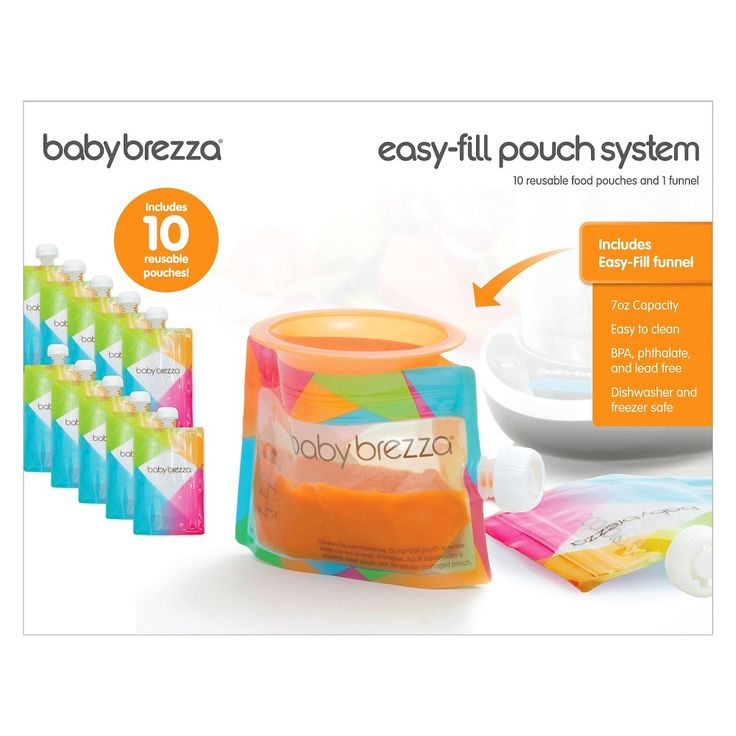
I recommend using a spoon when feeding these purees.
It is ok for toddlers to “suck” on these pouches occasionally.
However, make sure your tot has started spoon-feeding themselves, eating finger foods, and drinking from a cup with minimal spilling before giving them a pouch to “suck on.”
Don’t depend on pouches as a sole source of your child’s fruits and veggies, you want him or her to recognize and accept whole fruits and vegetables, too!
Get the Food & Nutrients for Baby’s Brain!
Keep Your Baby’s Nutrition in MindAs baby food pouches become more popular, however, parents want to make sure they fit them into the overall goals for their child’s nutritional needs and developmental progress.
Starting solids is a very important phase and there are a few overarching goals to keep in mind:
- Support your baby’s growth and development by supplying the nutrition he needs, especially for critical nutrients like iron, DHA and vitamin D.

- Advance your little one along with feeding skills. By a year of age, your baby should be self-feeding with utensils (and his hands), drinking out of a cup and eating a wide variety of flavors and textures.
- Setting up healthy eating habits.
With the fast-paced world we live in, it’s easy to put feeding on the back burner and give your youngster foods they can eat without your help.
Remember, feeding is a chance to connect and enhance attachment. When your child eats in the back seat while you drive, you miss out on an opportunity to connect.
A positive feeding relationship in infancy sets the stage for future healthy eating in toddlerhood, childhood and the teen years.
5 Pointers for Appropriate Use of Baby Food PouchesI’ve got a few pointers for using baby food pouches so your baby becomes the healthy, self-feeder he was meant to be!
1. Incorporate the Spoon
Incorporate the SpoonThe original intent when baby food pouches came out on the market was to use them with a spoon.
Parents could squeeze a bit of baby food onto the spoon and feed it to their infant.
Today, the spoon is skipped and sucking from the pouch is the norm. This misses the opportunity to teach baby how to eat off a spoon and use his mouth muscles to manage, propel and chew food.
All babies need diversified texture so they learn to chew, self-feed and advance their feeding skills.
Babies who do not advance to more textured food by 9 months of age have been shown to have a greater likelihood of having feeding problems later.
Using a pouch won’t hurt your baby if you keep moving forward with feeding skills, such as introducing finger foods, offering the spoon, and encouraging self-feeding.
2. Mix in More TextureAdd textured foods such as chopped and cooked veggies, rice, noodles or shredded meats in a bowl with baby food from pouches to increase the texture experience.
These varied textures will stimulate your baby’s sensory system and train his mouth muscles to handle a wide range of food textures.
3. Monitor Baby when Eating a Baby Food PouchNo matter what, when, or how you feed your baby, he or she needs to be monitored to watch for choking and to continue to enhance the parent-child connection and bond.
4. Start Finger Foods Between Six and Eight MonthsBetween six and eight months, babies develop their hand grasp and can hold a finger-shaped, or long, thin rectangle of soft food, such as buttered toast, soft cooked vegetables like sweet potato, or ripe fruit like banana or avocado.
By eight months, the pincer grasp emerges, and your baby can pick up small bits of food with his thumb and forefinger.
At this stage, introduce finer foods like strips and small cubes of soft food to your baby’s meal routine.
Use this opportunity to introduce singular veggies and fruits so your baby can appreciate the flavor and texture of these foods.
This is good advice for any child at any age (even adults), but especially for the new eater who is learning to handle food.
Sitting for meals and snacks helps children pay attention to their food and eating, learn to eat mindfully, and stop eating when full.
Your job is to provide quality nutrition and establish a good eating environment. Use developmentally appropriate feeding utensils and food textures to foster lifelong eating habits.
Need More Help with Feeding Baby?Check out our nutrition booklets, workshops, and courses and my book, The Smart Mom’s Guide to Starting Solids.
You may also enjoy reading:
- Is Rice Cereal for Babies Safe?
- Toxins in Baby Food: What You Need to Know
This article was updated on January 26, 2020.
5 Tips for Pouch Feeding by Pediatric Nutritionist Jill Castle – Once Upon a Farm
Pouches have taken the world of baby food and feeding by storm. They’re convenient, sterile, and tout a variety of interesting flavors and food combinations. They are certainly growing in popularity.
They’re convenient, sterile, and tout a variety of interesting flavors and food combinations. They are certainly growing in popularity.
Pouches are easy to use and give flexibility to parents, offering portable nutrition that’s in sync with the busy lifestyles many families have today. They also promote self-feeding and independence. All good stuff.
As baby food pouches become more popular, however, parents want to make sure they fit them into the overall goals for their child’s nutritional needs and developmental progress.
-
Advance your little one along with feeding skills. By a year of age, your baby should be self-feeding with utensils (and his hands), drinking out of a cup and eating a wide variety of flavors and textures.
To this end, I’ve got a few pointers for using baby food pouches so your baby becomes the healthy, self-feeder they were meant to be!
5 Tips for Parents Who Give Their Little Ones Baby Food Pouches
1. Incorporate the Spoon
Incorporate the SpoonThe original intent when baby food pouches came out on the market was to use them with a spoon. Parents could squeeze a bit of baby food onto the spoon and feed it to their infant. Today, the spoon is skipped and sucking from the pouch is the norm. This misses the opportunity to teach baby how to eat off a spoon and use his mouth muscles to manage, propel and chew food.
All babies need diversified texture so they learn to chew, self-feed and advance their feeding skills. Babies who do not advance to more textured food by 9 months of age have been shown to have a greater likelihood of having feeding problems later.
Using a pouch won’t hurt your baby if you keep moving forward with feeding skills, such as introducing finger foods, offering the spoon, and encouraging self-feeding.
2. Mix in More Texture Add textured foods such as chopped and cooked veggies, rice, noodles or shredded meats in a bowl with baby food from pouches to increase the texture experience. These varied textures will stimulate your baby’s sensory system and train his mouth muscles to handle a wide range of food textures.
These varied textures will stimulate your baby’s sensory system and train his mouth muscles to handle a wide range of food textures.
No matter what, when, or how you feed your baby, he or she needs to be monitored to watch for choking and to continue to enhance the parent-child connection and bond.
4. Start Finger Foods Between Six and Eight MonthsWe loved the convenience of the pouch, but it's still important to introduce finger foods. Between six and eight months, babies develop their hand grasp and can hold a finger-shaped, or long, thin rectangle of soft food, such as buttered toast, soft cooked vegetables like sweet potato, or ripe fruit like banana or avocado. By eight months, the pincer grasp emerges, and your baby can pick up small bits of food with his thumb and forefinger.
At this stage, introduce finer foods like strips and small cubes of soft food to your baby’s meal routine.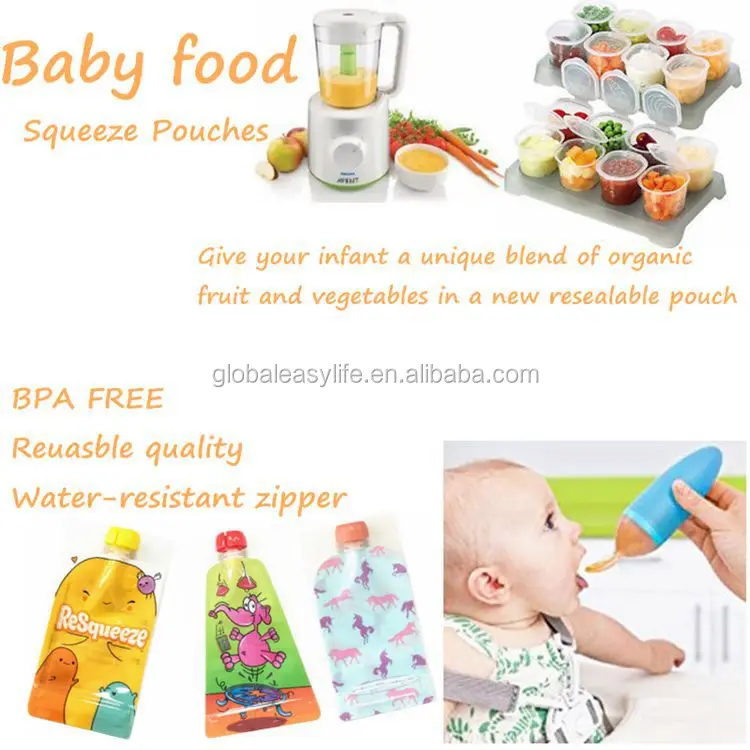 Use this opportunity to introduce singular veggies and fruits so your baby can appreciate the flavor and texture of these foods.
Use this opportunity to introduce singular veggies and fruits so your baby can appreciate the flavor and texture of these foods.
5. Always Sit to Eat
This is good advice for any child at any age (even adults), but especially for the new eater who is learning to handle food. Sitting for meals and snacks helps children pay attention to their food and eating, learn to eat mindfully, and stop eating when full.
- Written by Jill Castle, MS, RDN
Jill Castle is a registered dietitian and childhood nutrition expert who helps families navigate the ins and outs of feeding children from high chair to high school. She is the author of The Smart Mom’s Guide to Starting Solids, and the co-author of Fearless Feeding: How to Raise Healthy Eaters from High Chair to High School as well as many other resources for parents, including online trainings. You can find Jill’s blog, podcast and other resources on her website, http://www.jillcastle.com/.
You can find Jill’s blog, podcast and other resources on her website, http://www.jillcastle.com/.
Posted on: May 22, 2017
Posted by: Michaela Meehan
Tags:  Baby,  Education
From 4 to 6 months
Breast milk is the best food for your baby.
It is very important that the baby consumes breast milk for as long as possible.
The right age to start complementary foods
It is recommended to start introducing complementary foods into the baby's diet no earlier than 4 months, but no later than 6 months*. At this age, the baby is in the active phase of development and reacts with curiosity to everything new! Some babies at 4 to 5 months of age can no longer satisfy their appetite with breast milk alone and need complementary foods for healthy growth. Other children have enough breast milk, and they are ready for the introduction of complementary foods only after 6 months. The decision to start complementary foods should always be made according to your baby's development. Do you feel like your baby is not getting enough breast milk? Does your baby hold his head on his own, show interest in new foods or a spoon? Then it's time to start feeding. If in doubt, consult your pediatrician.
The decision to start complementary foods should always be made according to your baby's development. Do you feel like your baby is not getting enough breast milk? Does your baby hold his head on his own, show interest in new foods or a spoon? Then it's time to start feeding. If in doubt, consult your pediatrician.
If your baby spits out the first spoonfuls of puree, be patient. After all, he must first learn to swallow it. Start with a few scoops and give your child time to get used to the new form of feeding.
*Recommendation of the Nutrition Committee of the European Society of Pediatric Gastroenterology, Hepatology and Nutrition (ESPGHAN)
Why is complementary food important for the baby?
After 4-6 months of life, mother's milk or milk formula alone is not enough to supply the child's body with all the nutrients and necessary energy. In addition, the transition to solid food trains the muscles of the mouth. And finally, with the introduction of complementary foods, the child will get acquainted with the variety of taste directions, which is also important for his development.
When to start complementary foods?
Gradually replace one breastfeed with complementary foods. First for lunch, then for dinner and finally for lunch. The mouse eats breakfast with the usual dairy food.
Starting complementary foods with HiPP products is easy. The first spoons will be vegetable or fruit purees HiPP:
First step: lunch
We recommend that you start complementary foods at lunchtime with HiPP vegetable puree (for example, "Zucchini. My first puree", "Cauliflower. My first puree" or "Broccoli .My first puree"). Then, for satiety, feed your baby as always: breast or bottle. The amount of vegetable puree can be increased daily by 1 spoon. Be patient if your baby does not immediately love vegetables. Try repeating the vegetable puree in the following days. Next week, you can expand your diet with other varieties of HiPP vegetables (for example, "Carrots. My first puree" or "Potatoes. My first puree").
If your baby tolerates vegetables well, in the third week you can introduce grain porridge into the diet, and as a dessert, offer a few spoons of fruit puree enriched with vitamin C.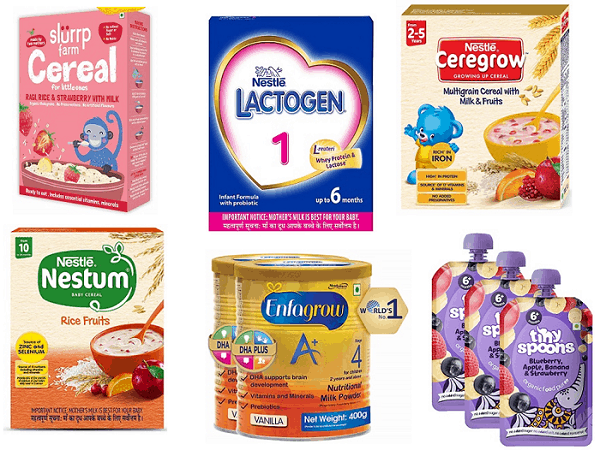 Vitamin C helps to better absorb iron in the body.
Vitamin C helps to better absorb iron in the body.
Once your baby starts eating a whole serving of mashed potatoes for lunch, you can eliminate breast milk or formula during that meal.
Tip: Reheat as much puree as needed for feeding. Store leftover puree in a sealed jar in the refrigerator. Use the contents of the opened jar within a day.
Important! If you are using a microwave, please remove the lid before reheating puree. Stir after heating. To prevent damage to the jar, please use only a plastic spoon. Always check food temperature before feeding.
from 6 months
HiPP product groups can be recognized by the following color coding:
Learn more: Advice
Video: Weaning introduction - OB tips Video: Baby massage Diet
From birth to 4 months From 4 to 6 months From 6 months From 7 to 9 months From 10 months to 12 months
Food and drinkDigestion of the babyOn holiday with the babyAllergySleepCrying of the babyMotor skills and speech
Choice of complementary foods
No age restrictions from the first daysfrom 1 monthfrom 4 monthsfrom 5 monthsfrom 6 monthsfrom 7 monthsfrom 8 monthsfrom 9 monthsfrom 10 monthsfrom 12 months
Choose a product categoryVegetable purees - Vegetable puree from 4 months - Vegetable puree from 5 months - Vegetable puree from 6 months - Vegetable puree from 7 months - Vegetable puree from 8 months Fruit puree - from 4 months - from 5 months months - from 6 monthsMeat purees - Meat pureesMeat and vegetable menu - from 8 months - from 12 monthsFish and vegetable menu - from 9Soups - from 6 months - from 7 months - from 8 months - from 12 months - From 18 months "Good night" in jars - Cereal porridge with fruits in jarsDrinks - Health drinks - Granulated teas - Tea bags - JuicesCookies - Cookies
Pediatrician explained why you should not give puree from bags to children
HealthNutritionBaby
- Photo
- Getty Images
pediatrician, Ph. D.
D.
From the soft pack, the puree only needs to be squeezed into the child's mouth. Later, sucking the puree out of the bag, he will learn himself. Pouch is convenient on the road, on walks and at home. Keeps well without refrigeration. The child loves them very much and asks for more. Lure without a spoon, a dirty table and bibs. At first glance, a real find for busy parents.
Not surprisingly, already in 2019, the New York Times wrote: “In the US, spiders account for 25% of all baby food sales.” Shelves with mashed potatoes in plastic can also be found in Russia. The choice of names and tastes is growing every year.
But are spiders as useful as they are convenient? What do pediatricians, nutritionists, and nutritionists say about spiders?
Experts agree that puree in soft packs does more harm than good. And in fact, there is practically no benefit. And that's why.
Firstly, the habit of eating from soft plastic packaging, sucking out the puree, interferes with the correct eating behavior of the child. For development, it is very important that the baby sees food, learns to handle a spoon, and can bite and chew pieces. So that he can study the product with his hands, lips, tongue. And at the same time there would be an opportunity to experiment with your food.
For development, it is very important that the baby sees food, learns to handle a spoon, and can bite and chew pieces. So that he can study the product with his hands, lips, tongue. And at the same time there would be an opportunity to experiment with your food.
The introduction of complementary foods serves the child not only as a source of additional nutrition. This is also a transitional time from dairy nutrition to a common table. Gradually, the child learns complex fine motor skills. Studies have shown that children on spiders later master the bite of food.
- Photo
- Getty Images
It is very important that the baby is in contact with the parent, and the food itself takes place in a relaxed atmosphere, at the dinner table. Eating for a baby is not only swallowing food from a package. This is an intensive communication with parents. Cognition of speech, signals, observation. The whole event for the baby. This is how his future eating behavior and addictions are formed.
Cognition of speech, signals, observation. The whole event for the baby. This is how his future eating behavior and addictions are formed.
Sucking a semi-liquid mass out of the package disrupts the development of normal eating and motor skills if the baby eats this way all the time. Moreover, it will be more difficult for a child to get used to normal multi-component and unsweetened food when a lighter and faster alternative is already well known - pouch.
Secondly, even if the package says “no added sugar”, they still contain sugar. Fruit or vegetable puree may be sugar-free, but when vegetables or fruits are processed, pureed, and then heavily concentrated, the percentage of carbohydrates can be much higher than their content in whole fruit. For example, a fresh peach contains 9.5g of carbohydrates per 100g, and peach puree labeled "sugar free" - 15.1g / 100g of product. One and a half times more!
For the same reason, European and American associations of pediatricians have excluded fruit juices from the diet of children under 1 year of age. Russian pediatricians recommend juices after 8 months. Not only because they contain more sugar, but also because juices are devoid of fiber that is useful for the baby.
Russian pediatricians recommend juices after 8 months. Not only because they contain more sugar, but also because juices are devoid of fiber that is useful for the baby.
- Photo
- Getty Images/iStockphoto
In addition, pouch puree is almost always based on some sweet fruit, not low-carb vegetables, even if they are large on the packaging. It is also not uncommon for children to receive a pouch even if they are not hungry. It happens that parents try to soothe their crying baby in this way and thereby overfeed him.
Excess carbohydrates threaten not only caries, but also a more serious problem - obesity. It is childhood obesity that is becoming one of the most difficult tasks in pediatric medicine. After all, according to recent studies, obese children under the age of three will remain obese in adulthood with a probability of 90% (A.